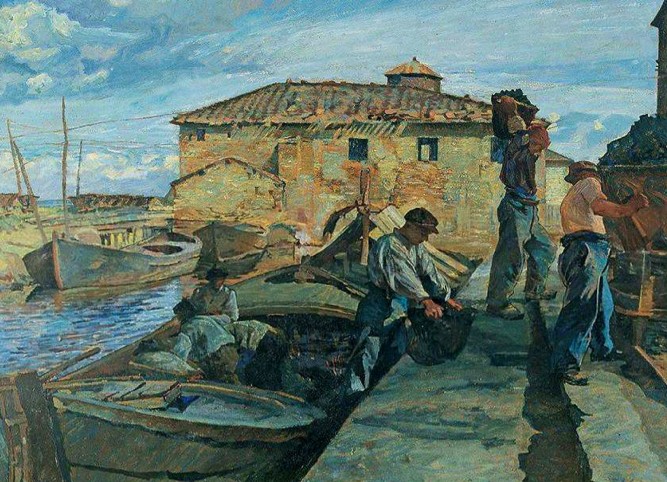Tuscany’s Other Puccini, the Artist

Just a few minutes drive from the Forte dei Marmi train station, the mountains part, funneling rays of sun into a spotlight onto Seravezza’s Medici villa. Two large rectangular towers stand imposingly, joined by an arched doorway and a blue banner heralding the opening of their new exhibition: a celebration of Mario Puccini and other post-Macchiaioli artists.
Entitled, “The Passion of Color,” the show takes visitors through Puccini’s tumultuous life, intermixed with his friends and influences. Giovanni Fattori’s “Oxen Grazing” is the first room’s signature piece; depicting oxen among the grass in a forest next to a man on a log, it exemplifies the Macchiaioli vision Puccini learned from and would emulate and expand upon.
Comparable to the subsequent French Impressionism, works from this late 19th century movement, named for “macchie” used to describe loose brushstrokes lending above all a sparkling quality. Composed of multiple layers, and a marked separation between the foreground and the background, canvases of this period capture the interplay of natural light. This effect is seen in the bright white “Oxen” poking their heads through the trees; yet, as each remains differentiated, the work is considered an example of early modernism that would influence Puccini.
Born in late 19th century Livorno, Puccini’s talent was recognized early, and he was sent to Florence’s Academy of Fine Arts at the age of 15. Very shortly after graduating, it is believed he learned of his girlfriend’s infidelity, which sent him into a depression that was later diagnosed as mental illness, resulting in a six-year stay at the Siena Psychiatric Hospital.
Three self-portraits best explain his transformation during this period: in 1890, before diagnosis, his color palette is traditional, with a solid, neutral dark beige backdrop and tones of browns and blues. Twenty-five years later, he painted two others, both washed in light blue tones, with scraped and dashed lines behind his head.
This night and day difference characterized the rest of his career; for though most of Puccini’s work during his hospitalization was lost, everything after has been marked by his innovative use of color.
Dubbed the “Italian Van Gogh,” he modified Divisionism, a close cousin of Pointillism, to fit his own style, sweeping the canvas with longer, thicker brush strokes instead of the tiny dots. Chunky orange and yellow rectangles are stacked one on top of the next to form the sunset spilling out onto the water in many of his paintings featuring the port of Livorno.
Puccini’s palette was also dependent on his location. While staying with his brother in Digne, sober navy blues and browns were most used, whereas in Italy, his landscapes exploded with intensely bright blues, crimsons, gold, and greens. He complemented this duality with different signatures: French pieces were signed “Pochein” instead of his Italian surname.
The exhibition displays paintings by contemporaries, showing both the masters Puccini learned from and the influence his works radiated into the community of artists who followed him. This juxtaposition highlights his deviation from standard practices, comparing strict adherents to Divisionism, such as his friend Plinio Nomellini, to his own efforts.
Human figures are of little to no importance: while cattle and other details of nature are in realistic, crisp detail, people’s faces are blurred. When the movement’s collective focus shifted to landscapes, bodies become little more than small smudges on canvas, unless specifically requested: a story tells that a patron returned “La Metallurgica” to Puccini, requesting he add people to the boatyard scene.
Llewelyn Lloyd’s “Church of Tonnarotti on Elba” is particularly noteworthy: though depicting a simple white building and its orange roof overlooking the ocean, the piece demands to be seen in person. Its canvas is textured with hardened rivers of residual paint that no print can accurately capture; every natural shade piled one on top of the other. The roof’s shadow cuts a jagged outline onto the walls while the indubitable serenity of the landscape radiates from the picture.
Though related to popular styles, the post-Macchiaioli movement and its host of artists linger in relative obscurity, neither celebrated nor discussed often today. Despite their bright colors and use of light, in true Tuscan fashion, Puccini and his friends are hidden gems.
“The Passion of Color” runs until November 2, open 5 pm – midnight Monday through Friday and 10:30 am – 12:30 pm, 5 pm – midnight Saturday and Sunday. From September 7 on, it is open Thursday through Saturday 3 – 8 pm and Sunday 10:30 am to 8 pm. Admission is €6, reduced €4. (bianca cockrell)
